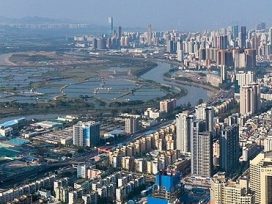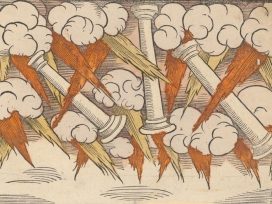Resurrecting the soil
What can the history of the soil tell us about modernity and its ills? An experiment in urban gardening sets Kate Brown thinking about the consequences of the western world’s perennial misuse of the land – and how to return life to today’s extinct terrains.
My shovel hit the earth with a ka-chunk. My friend and I were digging trenches to lay down a line of asparagus. We didn’t get far. The ground on a stretch of urban territory in Washington DC consisted of a thin layer of grass covering gravel mixed with burnt-orange clay. Clay is the iconic soil of the American South. In Margaret Mitchell’s novel Gone with the Wind, Scarlett O’Hara, the man-hungry party-girl, stands in the smoking ruins of the Civil War and longs for the ‘red earth of Tara’. In the novel’s conclusion, Scarlett realizes that, more than any man, her native soil ‘was her strength’.
Silly, cruel Scarlett didn’t know that the rolling fields of raw, red earth on her father’s slave-labour plantation were just a tattered remnant. Her ancestors had pillaged the rich, black topsoil of the Georgian Piedmont, leaving only a clay subsoil. That earthly impoverishment led to others. The more Southern planters stripped their farms of nutrients, the harder they beat their slaves to produce enough cotton, sugar and tobacco to bankroll the silks and barbecues Scarlett so enjoyed.
Until a person starts digging, the depletion of the ground underfoot goes unnoticed. Yet soils spread beneath us as important historical artefacts. The search for mineral nutrients has propelled the colonization of large parts of the globe. The crises over depleted soils inspired the first proto-environmental movements in the 19th century and had a lot to do with the creation of both the social welfare state and 21st century global capitalism.
Not that I’m the first to point this out. Since the 19th century, conservationists, economists, nationalists and environmental historians have written a great deal about soil quality and the ‘rape of the land’.1My experiment in trying to farm on disturbed urban territory got me thinking about how history might be changing with the molecular turn in biology. Scientists no longer think of soil as a collection of mineral elements. Molecular biologists have shown that billions of microscopic organisms dwell in healthy soils to form a superorganism of wondrous complexity. As I dug through rock and clay, I wondered how a history of this soil microbiome would read? Is it possible to populate the ground beneath my feet with the story of the tiny lives down there?
I looked under my spade. I had little to go on. There was almost nothing alive on this tuft of land on the edge of a public grade school. The site had been a staging ground for a major construction project. For two years, bulldozers, trucks and cranes had crawled back and forth, scraping and removing plants and earth, compacting and pulverizing the ground. After the renovation was complete, workers rolled out nylon landscaping nets, dumped a layer of commercial topsoil, pumped on some liquid nitrogen fertilizer and broadcast grass seed. It was good enough for a lawn but not for a vegetable garden.
Lawns are often dead zones. Shorn turf grass doesn’t feed native birds, bees, butterflies and it doesn’t sustain people in a city with high poverty and malnourishment rates in the midst of a pandemic.2 My friend Wesley and I wanted to see how many edible trees, shrubs and cover crops we could coax into life on the narrow banks of grass around the heavily-trafficked school. We started this project with no grand aspirations to feed the city, but just for fun and the challenge of it. Wes and I became friends while gardening on ground to which we had no claim. In a few years, we turned a trashy patch of no-man’s land into a flower-and-vegetable-filled garden that makes pedestrians slow down and look.
Making an edible forest around the grade school was a bigger project for which we had no budget, no staff – other than ourselves – and just a wee bit of permission from the school garden coordinator.
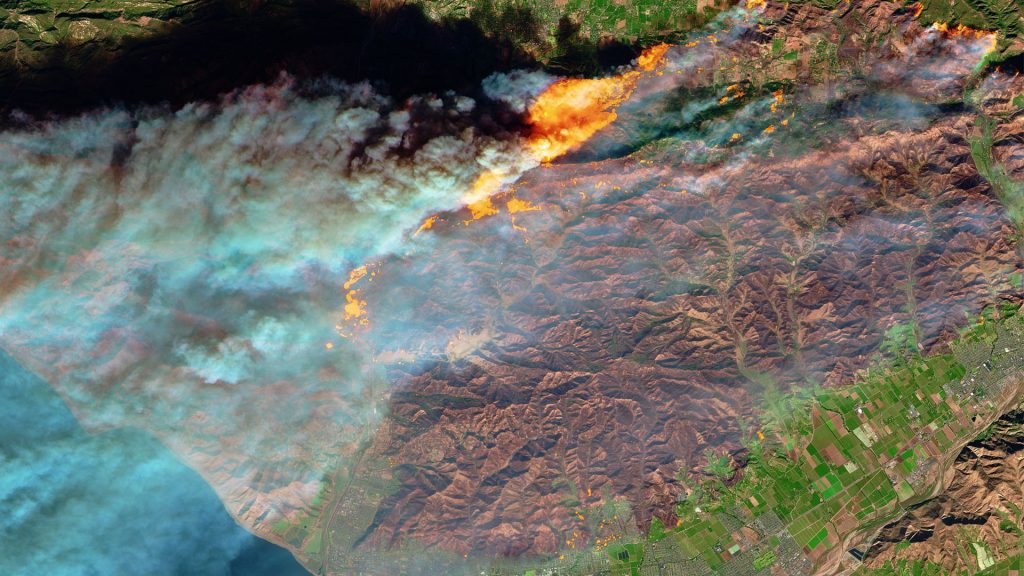
Satellite image of the Thomas Fire’s burn scar and active flames, in northern Ventura, California. Credit: NASA Earth Observatory images by Joshua Stevens, via Wikimedia Commons
A terrain of extinction
As spring warmed the ground, we began to plant. The school was mothballed so no one was around except for a pack of joyful children unleashed from classrooms, soccer practice and piano lessons. They paid us no mind as we rolled out wheel barrows and turned over the soil.
Once started, we had trouble stopping. Wes and I spaded up the fringes of the school’s community garden, setting down seeds of kale, spinach, arugula and wild flowers. We moved on to the east side to plant strawberries and asparagus. We spaded up ground for hardy berry bushes and fig trees along the school’s southern facade, which bakes as hot and dry as any Italian olive grove. We climbed the pad-locked courtyard fence to slip in native pawpaw and persimmon trees, while thumbing seeds of corn, beans and squash into the soil. These new edibles took root among struggling imported plants that the landscapers had laid down like carpet – and which are as nutritional as carpet too.
Wesley grafted fruiting apple branches onto ornamental trees and nestled tomato starts among decorative shrubs. We hoped the strawberry plants would spread as a cover crop to replace the English ivy where great clouds of mosquitoes breed. A city tree cutter gave us freshly-cut white oak logs. We inoculated them with the spawn of shitake mushrooms and stowed them in the shade of holly trees. Finally, we moved on to the marginal land on the west side of the school, where the cranes and trucks had rolled.
There, the soil had nothing to it. I dug in and lifted my spade to reveal a terrain of mass extinction. The ground held no worm, bug, root nor fungi. Nothing. As we dug, we unearthed only ‘foreign’ elements – glass, plastic, asphalt, brick and heavy, rust-iron nails. For a historian, it comes as no surprise that we live on ruins left by our predecessors, but I was in no mood for an archaeology expedition. My eye was on the future. Building soil, restoring dead ground to life during a pandemic was my route to overcoming the crushing weight of the past that is both my day job and a harsh daily reality in my neighbourhood.
Flattened ground aerates poorly and has trouble both holding water and draining it. We could see that even grass and invasive weeds had a hard time growing on the West side plot. Healthy soils are springy, lined with hair-thin roots and densely populated with a world of life in the form of insects, tiny animals, bacteria, viruses and fungi. Fungi send food and messages that zoom around the underground realm. Specialized bacteria ally with root tips, which serve as the command centre of plants. Azotobacter produces growth-stimulating chemicals. Rhizobium and Glomus work with roots to reduce disease in soils.3Another bacteria, streptomyces (the same helpful bacteria in human antibiotics), rescues thirsty plants during droughts.4If drought conditions continue, root bacteria can even mutate to alter their metabolism to help plants along. Other bacteria and fungi quarantine plants from insects and pests.5
Not all bacteria and fungi are beneficial. Some cause disease. Others are no more than free-loading parasites. It’s like any community. In my neighbourhood, some people are busy working, being good neighbours. Others are not so cooperative. A few even steal and fall into violent rages. That’s life. We take the good and the bad and mix them up to form our small worlds that live inside larger worlds.
Wesley and I debated what to do. We had no money or desire to buy sterile plastic bags of topsoil. So far, Wes and I had nourished our seedlings with leaf mulch and compost from kitchen scraps. That meagre stream had run dry. We looked into the school’s chicken coop. The chickens had checked into a suburban farm for the quarantine and their scat had been cleaned out. Wes pointed to an alley running along the forested park where trees drop leaves and branches on brick. Bacteria and worms had eaten those droppings and left behind a two-inch layer of soil. Wes thought to harvest it. We scraped away, mining three buckets, barely enough to line an asparagus bed. Better, we shrugged, than the red clay of Tara.
Dead presidents
Our problem of ravaged soils is one of the oldest in the history of agriculture. The first agricultural Homo Sapiens farmed and foraged on small islands in alluvial deltas, semi-watery places that flooded regularly. Spring deluges brought fresh nutrients to river basins like a dump truck arriving annually to spread a couple of inches of nutrient-rich earth in time for planting. Early humans engineered their settlements so that the hydraulic forces of rivers brought nutrients to them.6 They didn’t have to scrape brick and haul earth in buckets, while rubbing their sore necks.
Eleven thousand years ago, when humans settled down to farming, they enticed some animals to live with them. James Scott argues that most ancient farming communities, especially ones that relied on wheat or rice-based diets, invented lasting social institutions like social hierarchies, taxes and slavery. Compared to the easy life of hunting and gathering, farm work is repetitive, dull, physically taxing and time-consuming. Hunter gatherers were taller, fitter and healthier than their farming neighbours. If our ancestors had a choice, they chose foraging.
Farming had just one main advantage. Wheat and rice can be stored for long periods like money in the bank. Elites in early civilizations liked the wealth-accumulation part. They forced other people to do the boring farm work so they had time for ‘civilization’ – poetry, law, painting and science. The walls around early city-states, Scott speculates, functioned as much to keep enslaved workers in as to fend off invaders.7 Animals helped with the heavy lifting. Pigs and chickens roamed and ate the garbage that mounted in crowded villages. Animals, birds and humans consumed plants, turning them into manure that decomposed into refreshed soils to feed plants.
This human-animal-crop system hiccupped along for millennia with lots of misstarts and ‘collapses’ caused in part by soil degradation and famines themselves triggered by plant, animal and human epidemics.8 In the 18th and 19th centuries, the manure-crop cycle was adapted for urban life. In New York, soil collectors cleared privies during the night and loaded barrels of human waste onto barges heading for Long Island, where farmers bought the valuable human faeces. Farmers piled composted manure onto fields to grow vegetables which then sailed back across Long Island Sound to be sold to New Yorkers.9 That closed, organic cycle worked pretty well until the mid-19th century, when cities grew so large that the collectors couldn’t keep up. Women held their skirts up to wade across streets of horse and pig manure. Leaking cesspools drained into private wells. People got sick from faecal bacteria.
And not only poor people got sick. President William Henry Harrison was sworn into office on 4 March 1841. A month later he was dead. His doctors thought he had caught a fever during his long, boring inaugural address in a frosty wind. But notes of the dead president’s doctor reveal symptoms similar to those suffered by two presidents who followed him, James K. Polk and Zachary Taylor. Medical researchers, Jane McHugh and Philip Mackowiak, believe that the three presidents’ chills, fevers, and gastrointestinal distress point to enteric fever caused by infection from salmonella or paratyphi bacteria.10 Mid-century DC had no sewer system. The White House drew water from a nearby spring at Franklin Square.11 Seven blocks uphill from the spring tub, night soil collectors dumped slops onto a field, mixed it with horse manure, and spread it to dry and later sell on to farmers.12 As the city grew, so did the depository. A half mile away, the smell hit like a punch in the eye.13
A field overrun with slops quickly creates an eco-system spinning out of control. Faecal matter running into the Potomac River burped up a green algal bloom. The same dirty water spilling into a human belly lets loose a gassy geyser of bacteria. McHugh and Mackowiak speculate that bacteria from night soil flowed downhill into an aquifer that fed the Franklin Square spring. That spring water ran through underground wooden pipes to the White House. There, servants delivered the contaminated water in chilled silver pitchers to three mid-century presidents and one small boy.14
Among the millions of bacteria species, there are only a few hundred that are bad for you. One of them appears to have upset US history the way that a tiny ant spooks an elephant. Polk recovered from a bout of gastroenteritis only to die of another intestinal infection, cholera, three months after leaving office. Taylor too died of gastroenteritis while president.15 A few years later, little Willie Lincoln, the sweet-tempered son of Abraham and Mary, expired after a bout of typhoid fever. After Willie’s death, Mary Todd Lincoln was never the same.
Worried about murderous dirty water, city managers hooked up specially-built drain pipes that tunnelled human waste into the Potomac River.16 As American cities grew, underground arteries pumping faeces invisibly sutured together the muck of urban areas to surrounding rural landscapes. Urban sewer systems unquestionably improved urbanites’ health, but they precipitated an enormous scientific experiment gone wrong. Algae in rivers and lakes fed on phosphorus and nitrogen from faeces. The algae multiplied to turn clear water into floating green lawns. As the algae died and sank to the bottom, bacteria used oxygen to decompose it. As oxygen levels dropped, fish suffocated. Near Washington, especially the commercial varieties perished – shad, trout, herring and sturgeon.
Humboldt sneezed
At the time people understood that sewer lines severed the nutrient chain between humans and crops. Newspaper editor and abolitionist Horace Greeley called the practice of tossing away good compost to choke up local waterways ‘inexplicable stupidity’.17 He saw that soils in nearby fields no longer enriched with animal waste quickly wore out. As local farmland lost fertility, urbanites came to rely on food from farther and farther away.
No problem. There was always more land to be had for cash crops. In the 19th century, European and American adventurers headed abroad looking for riches as their forefathers had done. This time, they sought to mine new ground of nutrients to feed growing, urban populations at home. Unfortunately, most good agricultural land was already under the till. Russian tsars sent peasants into the dry Ukrainian and Kazakh steppes to grow wheat, which became Russia’s major export. In the decades that Harrison, Polk and Taylor fell ill from waterborne bacteria, the US Army wrestled the vast Southwest from Mexico. American leaders magnanimously ‘gave away’ this and other stolen land in the Homesteading Act.18
Many immigrants trundled to the arid plains, some fleeing Russia’s famished prairies.19 Meanwhile, Prussian settlers drove into Poland looking for land.20 German nationalists were disappointed that Poles had already cleared nutrients from their soils. For Prussian overlords, land and soil, debt and credit showed a nation’s wealth and the Polish-Jewish territories came up short.21 British and French officials supervised men to cut forests and plough under grasslands in India and Africa. Leaders in South Africa, New Zealand, Australia and Japan embarked on similar ventures on marginal land in their peripheries.22 It took only a few years for colonial settlers to wear out the new territory and start looking around for more.
You can see where this is going. The new imperialism of the 19th century drained much of the world’s lingering portions of accessible fertile land. The rate of ploughing under virgin territory outpaced even the rate of population growth, which was unprecedented.23 Settlers did not go easy on the land. They cut down forests and ripped through grasslands, sent topsoil sliding downhill and over riverbanks to create new geological features such as huge, artificial canyons, land-filled lakes and elevated rivers. Forests that served as biotic pumps sucking precipitated water from oceans deep into continental interiors were chopped down. Without forests, far less rain fell on the plains.24 Rain and wind swept unobstructed across disturbed ground, sending earth skyward. Within a few years of homesteading, farmers in Kansas noticed their soil thinning. Famines caused by man-made droughts and soil erosion convulsed the Russian Empire, China and British India at the turn of the 20th century.25
Nineteenth-century thinkers obsessed over the problem of degraded soils. Rosa Luxemburg spoke of the theft of earth right out from under workers’ feet. Karl Marx determined that all original sources of wealth grew from the soil first and workers second.26 Marx ended his life reading about soil science and fretting over the ‘metabolic rift’: the failure of farmers to return nutrients to the ground they have worked. Charles Darwin in his dotage became fascinated with the soil-building properties of earth worms.27 Early 20th century conservationists often wrote about ‘desertification’. Nothing short of a miracle, they worried, would halt the tip toward soil exhaustion that threatened to turn all of Planet Earth into a vast desert.
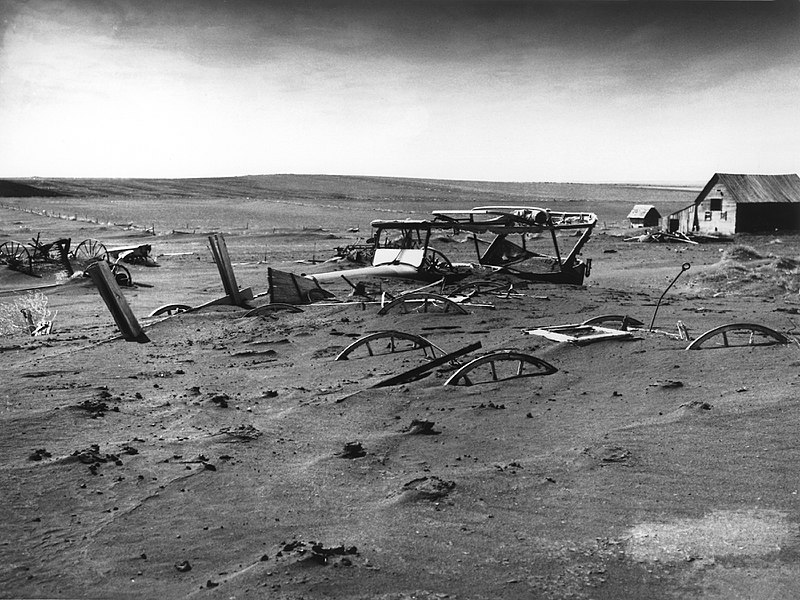
Buried machinery in barn lot in Dallas, South Dakota, during the Dust Bowl. Photo by United States Department of Agriculture, via Wikimedia Commons.
And then Alexander von Humboldt sneezed. Travelling in South America, the Prussian polymath noticed Peruvians unloading grey baskets of a dusty substance that made his nose twitch. He inquired and learned it was guano, the faeces of bird that had fed on fish and landed on coastal rocks to relieve themselves. Humboldt brought a scoop of guano home and chemists analysed it. The guano was rich in nitrogen, potassium and phosphate, just the nutrients that plants on famished ground hunger for. A few experiments showed that crops flourished in guano rich soils. Soon, everyone wanted it.
By mid-century, the quest for nitrogen sources led to a new round of colonization. The United States passed the Guano Islands Act in 1856. They raced Great Britain, Peru, Ecuador and Chile to poke their flag down on every rocky, bird-shit coated outcropping they could find. British leaders took hold of Namibian guano. In 1879, Peru and Bolivia went to war against Chile for access to a Chilean-owned mines of sodium nitrate, a guano substitute. The name of the disputed mineral ‘Chilean saltpeter’ tells you who won that war.28 But there was never enough. Farmers ran through the original supply of Peruvian guano in just a few decades. Prices for Chilean saltpeter rose.
Watching world populations multiply while soils grew exhausted, pundits predicted an approaching calamity – an intellectual fixation which historian Thomas Robertson calls ‘environmental Malthusiasm’.29 Agronomists fretted that degraded land reduced the earth’s ‘carrying capacity’, a term borrowed from ranchers to calculate how many animals or people a patch of ground could sustain. German thinkers worried especially. If Germany had a conflict with a superior naval power (say Great Britain), they would be cut off from Chilean nitrate imports. Germany was addicted to imported nitrates for both fertilizer and explosives. Historians often fix on historical actors that move about, vote and wage war. In this case the deficit of one tiny nitrogen molecule stood to knock over the powerful German state. For a century German scientists tried to ‘fix’ nitrogen in the air to a form they could use, a simple task which plants cooperating with microbes do reflexively.
It took a hundred years before the German chemist Fritz Haber devised a high-energy method using lots of heat and pressure to combine atmospheric nitrogen with hydrogen to form ammonia or nitric acid. The engineer Karl Bosch scaled up Haber’s invention, showing that all it took to produce ammonia were huge factories with gobs of fossil fuels – energy ancient plants had captured from the sun millennia before. Bosch drew up blueprints for the Oppau ammonia factory in 1909, the same year that one-thousand people met in Budapest for the first international conference on soil science. The attendees had no idea that the ‘Haber-Bosch’ process, an invention whose impact on human history rivals the steam engine and the splitting of the atom, would flip the ratio of nitrogen on earth from scarcity to glut.
But before that development, the unlucky convergence of the Haber-Bosch process with WWI diverted the wondrous technology from food to war.30 In the spring of 1915, a blockade severed Germany from Chilean nitrates just as barrels of nitric acid rolled off the line in time to make explosives. Bomb after bomb dropped on sorrowful fields of soldiers dug into mud like miserable human earthworms. Bombs packed with nitrogen lit up the soldiers’ half-buried forms and killed them like no war before.
A tsunami of nitrogen
After WWI, the soil problem intensified. A British agronomist, Gilbert Fowler, dismissed industrial nitrogen as a fertilizer. Farming was not just chemistry, he argued. Plants needed much more than a few simple molecules. After a typhoid outbreak in 1909, Milwaukee’s ‘sewer socialists’ hired Fowler to design a waste treatment facility. Fowler’s state-of-the-art plant turned Milwaukee’s sludge into nitrogen and phosphorous-rich fertilizer. Thanks to the treatment facility, human waste no longer poured into Lake Michigan, a development that saved residents from lethal illness, rescued fish from algae blooms and liberated everyone from a putrid stench. Fowler’s design could have radically changed global history by reproducing on an industrial scale ancient farm practices that recycled organic nutrients.31 But Fowler and Milwaukee’s sewer socialists became just a footnote. As Fowler’s waste treatment plant opened in 1925, the Haber-Bosch process made commercial nitrogen cheap, curbing the desire for recycled human waste.
Fowler went to India to learn more from Indian farmers who composted night soil effectively. His work inspired Albert Howard, an English botanist also stationed in India. Howard became the modern proponent of ‘organic farming’, a new term for old practices. His basic tenet held that farms should close the cycle of nutrients from soils to crops and back again. Some contemporaries took this idea further. The Indian botanist Jagadis Chandra Bose and the Austrian Goethe scholar Rudolf Steiner saw a ‘vital force’ in soils. Bose speculated there existed no break ‘in the life processes that characterized the animate and inanimate world’. 32 Steiner, following the German romantic tradition, thought a farm should be treated as a living organism. Soils, like plants and animals, were alive, Steiner taught his disciples. Plants were the ‘belly on the farm’ while soil made up the diaphragm helping to move air, water and nutrients from earth to plants.33
Steiner’s ‘biodynamic’ followers meditated over seeds and filled cow horns with manure to bury in autumn when the moon was on the wane. Unearthed after six months, the horn’s minute contents were used to fertilize acres of crops. Most commentators reject Steiner and his followers as unscientific and ‘mystical’.34 But what Bose and Steiner called ‘vital’ conveyed the insight that scientists increasingly understand today: that microbial life under our feet works in concert with insects, worms, plant roots and fungal arteries to create a living world of creativity and mastery, one which scientists are just beginning to grasp.
For fifty years, the insights of these early soil activists were sidelined. Long-standing soil degradation crises escalated the Dust Bowl to media superstar status.35 Photographers captured bilious clouds of airborne soil curling like detonated bombs over Kansas hamlets. With images of displaced Dust Bowl farmers seared in memory, Americans went to war again in 1941. The US War Department subsidized ammonia plants to produce explosives. By 1943, they produced more than needed. Companies sold the surplus to farmers.
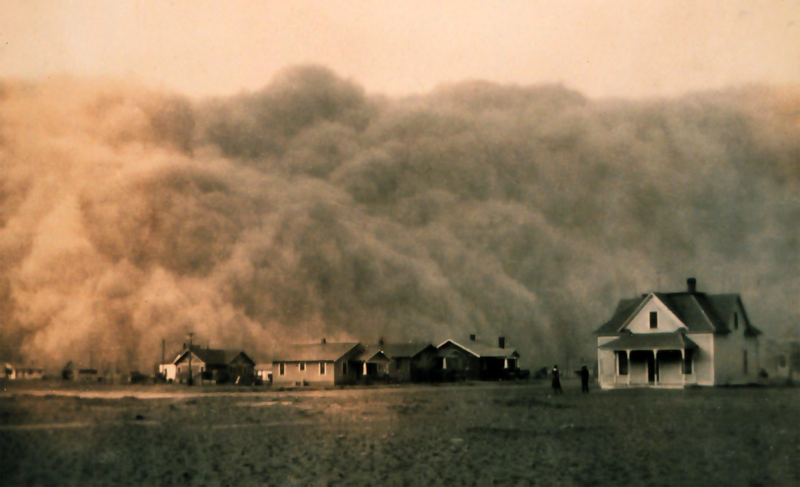
Dust storm approaching Stratford, Texas. Photo by NOAA George E. Marsh Album via Wikimedia Commons
After the war, marketers promoted a new thought – not only could nitrogen fertilizers restore depleted soils, they could increase crop yields too. More food per acre could feed growing global populations. Agronomists in the US encouraged farmers to pack in a lot of ammonia – 280 pounds per acre. They developed hybrid seeds that could handle this tsunami of nitrogen that sickens many plants. Farmers who used to save their own seeds and manage their own nutrient cycles got hooked into buying hybrid seeds, commercial fertilizer, pesticides, herbicides and heavy machinery to distribute it. These technologies were expensive, polluting and produced less nutritious food. But they spread like wildfire because they turned producers – farmers – into voracious, dependable consumers. And that was good for business.36
Americans exported this new Green Revolution abroad. Soviets picked it up and spread the model to their satellite states. China, devastated by famine in the fifties, jumped on board the inorganic nitrogen train. Ammonia pipelines carried liquid nitrogen from plants directly to fields.37 So efficient, so effective. Men like Norman Bourlag, the ring master of the Green Revolution and a tireless promoter of American Empire, took it upon themselves to feed six billion people on earth with these technologies. Bourlag was so successful feeding the masses that, within a decade, biologist Paul Ehrlich famously revived the fear of a ticking ‘population bomb’ buried under all those nitrates.
As farmers poured nitrogen onto their fields, dearth flipped to excess. Nitrates and nitrites that flowed into water sources reached tap water and poured into the bodies of commercial animals and humans. Excess nitrogen turned babies blue and transformed clear ponds into glistening green lozenges. We don’t yet know the full health costs of all that excess nitrogen in the food cycle, but studies indicate that nitrate intake causes several kinds of cancer and thyroid disease.38 We do know the impact on the planet’s health. The Worldwatch Institute estimates that up to 51% of greenhouse gas emissions comes from the agricultural supply chain; a good portion of that from excess fertilizer run-off that feeds microbes who produce nitrous oxide. 39
The Green Revolution was also tough on the health of economies. Small farmers who could not finance large agricultural inputs lost out to big farmers who bought up ever larger portions of the territorial pie.40 At the turn of the 21st century in the US, 1.3% of the population feeds everyone else.41 Agribusiness leaders argue they can’t feed a projected nine billion people without industrial agriculture. We can’t live without it; we have trouble living with it. This is the box Wes and I were born into.
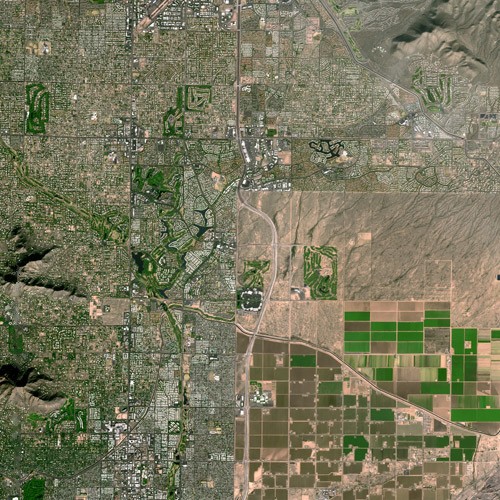
East part of Phoenix (on the left) and Scottsdale, Arizona (on the right) by SPOT Satellite. Photo by Cnes – Spot Image from Wikimedia Commons
A new age of discovery
Then the pandemic hit. Supply chains collapsed. Guards halted migrant farm workers at the border. Farmers destroyed produce they could not distribute. Grocery store shelves thinned out and lots of people turned to their gardens. We had trouble finding seeds in the spring of 2020. There was a run on baby chicks for backyard coops. Over a thousand people signed up for a DC beginner urban gardening class (only 100 could participate on Zoom).
As we scrapped over rocky ground, I doubted we had enough nutrients for our crops to thrive. I’d read a study about a successful and affordable supplement called ‘Bloom’, made by the DC waste treatment plant. This ‘state-of-the-art’plant adhered to the general concepts that Gilbert Fowler engineered in 1915. Using high temperatures and pressure in an oxygen-free environment, the plant cooks Washington sludge and produces a fertilizer which April Thompson, the plant’s marketing director, told me is clean enough to be labelled organic (though it is not). Unlike most American cities of its size, DC waste water has little industrial waste, which makes Bloom cleaner than the usual ‘biosolid’.
I suggested to Wesley that we use it to enrich our crops and end Marx’s metabolic rift. Wesley wasn’t so sure he wanted to farm with what we Washingtonians flush. A lot of things end up in our drains – cleaning fluids, condoms, oil runoff. A lot of unsavoury products migrate through our bodies too – pesticides, herbicides and antibiotics from commercial foods, anti-depressants, opium and artificial oestrogen from prescriptions. Environmental Protection Agency inspectors in the US do not test bio-solids, products like Bloom, for most of the 80,000 unregulated pollutants in composted waste.42 We humans are an amalgam of the worlds we live in. We literally incorporate the technologies we create, many of them toxic. Human waste, Wesley pointed out, has come a long way since the more biologically-innocent night soil days of the 19th century.
My view was that since farmers today use Bloom and other ‘biosolids’ as fertilizer for our food, we might as well know what is in it. If people realize that what they flushed down the toilet comes back to them on their dinner plates, then they might be more thoughtful both about what they consume and toss down the drain. ‘If everyone just ate plant matter’, Thompson from Bloom exclaimed over the phone, ‘we’d have no problems at all’.
Wesley preferred to use the biodynamic method – that is the soil enrichment programme Rudolf Steiner’s followers developed based on a dozen lectures Steiner gave in 1924. We decided to try both.
A dump truck left us a huge pile of smouldering Bloom cut with wood mulch. It smelled like a barn (or maybe worse). I plunged my shovel in. Steam floated up, wafting humid, sauna-thick air. Millions of bacteria in the pile were working away, getting heated up as they dined and burped carbon. Even through my glove, the pile was hot to touch. For days, we carted the compost to perennial plant beds. Bloom did the job we needed covering eroded ground of gravel and clay. That was good, but as fine particles coated my throat, I began to feel I’d like a bit more social distance from my community’s faecal matter.
Wesley ordered a horn stuffed with manure that had been buried for the winter on a farm in Eastern Maryland. We waited until the last quarter moon, dumped the horn’s few ounces of manure in a bucket of water and stirred vigorously with our hands for half an hour. We placed the brew in plastic aerators and misted it over our garden beds. Compared to hauling Bloom, biodynamic farming felt like a sunny day at a spring fair. But I wondered how that tiny bit of misted cow manure could fertilize all our crops?
I attended a webinar and learned that biodynamic farming is not as crazy as it sounds. The particular cocktail we made took microbes of a cow brewed in dirt from a local farm with microbes from our left and right hands (they are different). These particular microbes joined in the bucket to form the ‘vital matter’ our gardens so needed. The hope was that the brew contained bacteria called ‘autotrophs’ which function like the city’s waste treatment plant, producing nitrogen but with no great inputs of thermal energy.
Microbes can mutate as quickly as every twenty minutes, fast-forwarding to adapt to their micro-local environments.43 In really dirty locations, some work like military mine sappers, learning how to digest the most toxic pollutants in urban environments such as arsenic, solvents, inorganic fertilizers and coal tar. NYU scientist Elizabeth Hénaff has isolated a bacteria, Pseudomonas putida, that consumes toluene, a paint solvent that damages the nervous system. ‘It’s really beautiful to think that even in the depths of the darkest human mistakes, nature is able to respond’, says Hénaff.44
A soil test came back showing we had a lot of lead in our soil. I walked by our self-heating pile of Bloom, thinking that if the right microbial mix evolved in there, bacteria could do the work of cleaning up both man-made toxins in our biosolids and the ground. But I didn’t know for sure. We now live in a new age of discovery. Scientists are just beginning to explore the depths of the underground microbial realm. If only a tiny Robinson Crusoe could sail into that pile and discover the uncharted world of dark matter living there.
After planting, we stepped back and watched. The plants fertilized by Bloom grew swiftly at first, but, as the heat and drought of high summer rolled in, the Bloom soils dried up fast and a hard crust formed on the surface. We had to chop the ground to pry it open and water more. In the biodynamic beds, the plants grew modestly but steadily. They were better at retaining moisture. In both kinds of beds, fat worms slunk around; roly-polies scurried, roots grew wildly and our plants flourished. A whole little farm on a quarter acre of public land in a crowded city.
I did not see any tragedy in these commons. Rather it was a tiny success. I was struck by how easy it was to regenerate the soil (albeit on a microscale). As our plants grew, they created plant material that we mulched back into the ground. Worms and microbes set to work breaking it down. The beds turned dark brown, springy; they lifted from the earth. It was a kind of resurrection that doesn’t require faith in miracles.
For a discussion of ecofeminist interpretations of the 1980s ‘rape of the land’ concept, see: S. R. Wilson, ‘Rape of the Land’: 21st Century Ecofeminism and Environmental Rape Culture’, Oak Tree Notebook, 24 February 2016, https://oaktreenotebook.com/2016/02/24/rape-of-the-land-21st-century-ecofeminism-and-environmental-rape-culture/(last accessed 12 July 2020).
13% of D.C. households are food insecure and struggle with hunger; 19% experience food hardship and did not have enough money in the past year to buy food for themselves or their family; and 37% of households with children are unable to afford enough food. S. O’Hara, ‘Food Security: The Urban Food Hubs Solutions’, Solutions, Vol. 6, No. 1, January 2015, 42–53.
S. N. Pandey et al., ‘Classification of Soil Microorganisms’in Plant Microbiome: Stress Response, eds D. Egamberdieva and P. Ahmad, 1–19. Microorganisms for Sustainability, Singapore, Springer, 2018. https://doi.org/10.1007/978-981-10-5514-0_1
A. K. Hunter, ‘Microbes in Soil Help Sorghum Stay Strong Against Droughts,’ Inside Science, 17 April, 2018. https://www.insidescience.org/news/microbes-soil-help-sorghum-stay-strong-against-droughts
J. Sabotič, et al., ‘L-Amino Acid Oxidases From Mushrooms Show Antibacterial Activity Against the Phytopathogen Ralstonia Solanacearum’ Frontiers in Microbiology, 11, 2020. https://doi.org/10.3389/fmicb.2020.00977
J. C. Scott, ‘Against the Grain: A Deep History of the Earliest States’, Yale University Press, 2018.
Ibid. chapters 1 and 2.
D. R. Montgomery, Dirt: The Erosion of Civilizations, Berkeley, University of California Press, 2012, x.
Ted Steinberg, Down to Earth: Nature’s Role in American History, Oxford, 2019, 145–9.
J. McHugh and P. Mackowiak, ‘Death in the White House: President William Henry Harrison’s Atypical Pneumonia’, CID, 59, 1 October 2014, 990–6.
‘Spring Water, a Peril: Contamination in Well Near Franklin Square’, Washington Post, 3 September 1905.
‘Impure Air’, The Evening Star, 7 July 1856.
‘The Excrement Nuisance’, The Evening Star, 23 June 23 1856.
‘Franklin Square’s History Intrigues’ Washington Post, 22 September 22 1929.
J. McHugh and P. Mackowiak, ‘Death in the White House: President William Henry Harrison’s Atypical Pneumonia’ CID, 59, 1 October 2014, 990-6.
‘Typhoid due to water: Deadly Fever Germs found in the Potomac Supply’ Washington Post, 7 December 1900; and ‘New Sewage Pumping Plant’ Washington Post, 4 August 1901.
Steinberg, Down to Earth: 145.
Hannah Holleman connects empire with white supremacy and the search for soils; see Dust Bowls of Empire: Imperialism, environmental politics and the Injustice of Green Capitalism, Yale, 2018: 104.
K. Brown, ‘Gridded Lives: Why Kazakhstan and Montana Are Nearly the Same Place’ American Historical Review / American Historical Association, 2001.
D. Blackbourn, The Conquest of Nature : Water, Landscape, and the Making of Modern Germany, New York, Norton, 2006.
Gustav Freytag’s 1855 novel Debt and Credit illustrates this equation of soil and race well.
H. Holleman, Dust Bowls of Empire: Imperialism, Environmental Politics, and the Injustice of ‘Green’ Capitalism, Yale Agrarian Studies, New Haven, Yale University Press, 2018, 70.
V. Smil, Enriching the Earth: Fritz Haber, Carl Bosch, and the Transformation of World Food Production, Cambridge, Mass, MIT Press, 2001, 39.
M. Makarieva and V. G. Gorshkov, ‘Biotic Pump of Atmospheric Moisture as Driver of the Hydrological Cycle on Land’, Hydrological Earth System Science, 2007, 21.
D. R. Montgomery, Dirt, 126.
H. Holleman, Dust Bowls of Empire, 103-4.
E. Coccia, The Life of Plants: A Metaphysics of Mixture, trans. D. J Montanari, Cambridge, UK, Polity Press, 2019, 42.
V. Smil, Enriching the Earth, 46.
Robertson, The Malthusian Moment, 13-24.
V. Smil, Enriching the Earth, 101–3.
H. S. Gorman, The Story of N: A Social History of the Nitrogen Cycle and the Challenge of Sustainability, Rutgers University Press, 2013, Vol. 112, 121–22.
J. C. Bose, Alternative Sciences: Creativity and Authenticity in Two Indian Scientists, Allied Publishers, New Delhi, 1980.
C. Treitel, Eating Nature in Modern Germany: food, agriculture, and environment, c.1870 to 2000, Cambridge, Cambridge University Press, 2017, 181.
Venus Bivar, Organic Resistance: The Struggle over Industrial Farming in Postwar France. Chapel Hill: The University of North Carolina Press, 2018, 77.
Paul Sutter argues that the Dust Bowl was just a sideshow to a much greater tragedy of soil depletion in the American Southeast. See: Let Us Now Praise Famous Gullies: Providence Canyon and the Soils of the South, Athens, University of Georgia Press, 2015.
H. S. Gorman, The Story of N, 93–7.
V. Smil, Enriching the Earth, 138.
M. H. Ward et al., ‘Drinking Water Nitrate and Human Health: An Updated Review’, International Journal of Environmental Research and Public Health, Vol. 15, No. 7 (23) 2018.
J. McMahon, ‘Why Agriculture’s Greenhouse Gas Emissions Are Almost Always Underestimated', Forbes https://www.forbes.com/sites/jeffmcmahon/2019/12/02/5-reasons-agricultures-greenhouse-gas-emissions-are-usually-underestimated/#2dd529286ac8; the higher estimation of GHG outputs is disputed. See: C. Oertel et al., ‘Greenhouse Gas Emissions from Soils – A Review’, Geochemistry, Vol. 76, No. 3, 1 October 2016, 327–52; and T.D. Searchinger, et al., ‘Assessing the Efficiency of Changes in Land Use for Mitigating Climate Change’, Nature, Vol. 564, 2018, 249–253.
V. Shiva, The Violence of the Green Revolution: Third World Agriculture, Ecology and Politics, London / Atlantic Highlands, NJ, USA, Zed Books; Penang, Malaysia, Third World Network, 1991.
Sarah Lepley, ‘9 Mind-Blowing Facts about the US Farming Industry,’ Market Insider, 30 May 2019, online at: https://www.businessinsider.com/farming-industry-facts-us-2019-5
US EPA, Office of the Inspector General, ‘Report: EPA Unable to Assess the Impact of Hundreds of Unregulated Pollutants in Land-Applied Biosolids on Human Health and the Environment’, Reports and Assessments, 15 November 2018. https://www.epa.gov/office-inspector-general/report-epa-unable-assess-impact-hundreds-unregulated-pollutants-land
GPEARI,‘Bacteria Mutate Much More Than Previously Thought’, ScienceDaily, https://www.sciencedaily.com/releases/2007/08/070818112338.htm (last accessed 11 July 2020).
M. Wilson, ‘The City of Tomorrow Is A Petri Dish–By Design’, Fast Company, 3 November 2016 https://www.fastcompany.com/3065152/the-city-of-tomorrow-is-a-petri-dish-by-design (last accessed 1 June 1 2020).
Published 24 July 2020
Original in English
First published by Vikerkaar 7-8/2020 (Estonian version) / Eurozine (English version)
Contributed by Vikerkaar © Kate Brown / Vikerkaar / Eurozine
PDF/PRINTPublished in
In collaboration with
In focal points
Newsletter
Subscribe to know what’s worth thinking about.
Related Articles

Democracy in the US is under threat from within. Racial nationalism – a throwback to unresolved tensions from the American Civil War – has found new impetus under Trump, forcing civic nationalism into a corner. Will the immutable longevity of the American Constitution be its paradoxical undoing? And how might the US recover from its emerging dictatorship?

Liberty on the line
Index on Censorship 2/2025
Free speech in the US: how book bans are targeting independent thought; why Trump’s assault on education imitates Erdoğan’s; what the closure of Radio Free Asia means for the region’s information space; and how American liberals can learn from Soviet dissidents.




